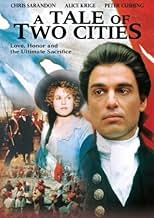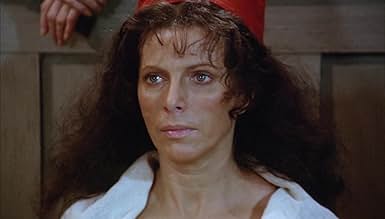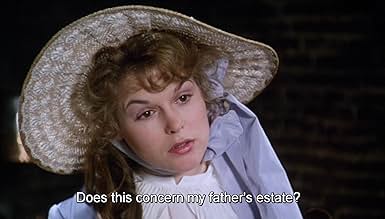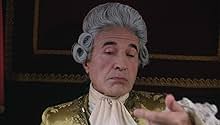CALIFICACIÓN DE IMDb
6.6/10
1.1 k
TU CALIFICACIÓN
Agrega una trama en tu idiomaAn ex-aristocrat from France and an alcoholic English lawyer find themselves crossing paths and in love with the same woman during the French Revolution.An ex-aristocrat from France and an alcoholic English lawyer find themselves crossing paths and in love with the same woman during the French Revolution.An ex-aristocrat from France and an alcoholic English lawyer find themselves crossing paths and in love with the same woman during the French Revolution.
- Nominado a 1 premio Primetime Emmy
- 2 nominaciones en total
Valérie de Tilbourg
- Seamstress
- (as Valerie de Tilburg)
- Dirección
- Guionistas
- Todo el elenco y el equipo
- Producción, taquilla y más en IMDbPro
Opiniones destacadas
A Tale of Two Cities is a wonderful book, ranking Dickens' works it's to me towards the top. It is wordy with a very complicated story, but it is also very compelling and the characters especially Sydney Carton and Madame Dufarge are memorable. This 1980 version is not the best(the 1935 film) or worst(the animated Burbank Films Australia version) of the book, but adaptation-wise and on its own it's very decent. It is hampered by Chris Sarandon's stiff and emotionally cold Charles Darnay, a rather cheap, under-populated and lacking-in-suspense-and-urgency storming of Bastille scene and the on-the-saccharine-side romantic theme in the music score. The adaptation could also have done a better job at differentiating between Charles and Sydney, visually especially with the hair they are never quite distinctive enough. But the production values are generally quite decent, it does at least make an effort to be true to Dickens and the historical period it's based in and they have good colour and atmosphere if lacking somewhat in refinement. The music serves the adaptation well, while the script is intelligently adapted and does nobly with conveying Sydney's sardonic humour, the heartfelt tragedy at the end and the dark, foreboding humanity. The story is faithful in spirit to the book, though there are things inevitably missed out, and doesn't feel too confused. It's solidly paced too. With individual scenes the standout has to be the ending which is extraordinarily moving, though the final forty minutes generally is very suspenseful. The acting is fine on the whole. While Sarandon disappoints(to me at least) as Charles he is outstanding as Sydney- that Sydney is a far more interesting character helps-, he is humorous and sardonic while also poignant and dignified. Alice Krige is an emotive and beautiful Lucie, Flora Robson's Miss Pross is regal and loyal and Barry Morse is rightfully hissable as Evremonde. Billie Whitelaw is fine as a very snake-like Madame DuFarge, David Suchet characterises the conflicted character of Basard brilliantly and beautifully, Peter Cushing is perfect as Dr Manette and Kenneth More is more than competent too. George Innes does a very good job too as Cruncher, very sly and funny, but the character could have been more prominent. In conclusion, decent version, worth watching but for the best adaptation look to the 1935 film. 7/10 Bethany Cox
I saw it as part of his characterization that Chris Serandon didn't show very much emotion as Carton in the end. It came across, at least to me, as trying to be strong for the sake of the other characters in the movie. I also thought that that was a great amount of emotion displayed in Darnay's supposed final meeting with Lucie after he is condemned. That aside though, I think I've decided I like the movie better than the book because Charlie is just a little bit too wordy for my taste. That's what we get for paying him by the minute...
10kwongers
First things first: I have to say I have never read Charles Dicken's book, but after seeing this movie, I'll be stopping by the state library to pick it up. This is a GREAT movie - enjoyable, moving, and historically convincing. (My history teacher made us watch it to see what the French Revolution (especially the Reign of Terror) was like.)
After reuniting with her father, Dr. Manette (they had been separated from each other for many years), Lucie Manette goes back to England, where she meets a handsome stranger, Charles Darnay. Darnay is really Charles Evremonde, a French aristocrat who disdains his vain and arrogant uncle and who runs away from France. They fall in love and marry. But there is an English lawyer, Sydney Carton, who also loves Lucie. When Darnay returns to France to save his servant, he is thrown into prison and besieged by all the foolishness and speculation of the French Revolution. I won't divulge any more of the story to you.but I have to say the ending is really, really great. It's so moving that I can't watch it without crying at least a little. (Yeah, I cried when we were watching it at school, and hopefully no one saw me.)
For others who know the story, I can't tell you if the movie lives up to the book, but I do think the movie is a very convincing depiction of what happened during the French Revolution. Madame DeFarge, one of the `revolutionaries' (ha!), embodies the spirit of the common people during the Revolution. She felt it was absolutely necessary to kill a lot of nobles, even if they were innocent and had done nothing wrong. In the court scenes, we see how unfair the French tribunals are; defendants are barely given the chance to speak and they are convicted on little evidence and a lot of speculation. (The film compares the French court to the English court, which is infinitely more just.) We see the so-called anti-Revolutionaries being marched to the guillotine.it's a very moving moment. The film works very well because it doesn't lose any part of the story or the historical background. They work very nicely together.
To single out someone for acting, I have to commend the talented Chris Sarandon, who played Sydney Carton and Charles Darnay. That must have been really hard to do, especially since Darnay gets everything he wants and Carton doesn't. It's great acting. However, Sarandon manages to stay on course and the results are wonderful. He manages to combine jealousy, love, and strength all in the same gaze.
A WONDERFUL film.it gets your anger going, pulls on your heartstrings, and keeps you perfectly enraptured through the entire running time. I loved this movie. 10/10
After reuniting with her father, Dr. Manette (they had been separated from each other for many years), Lucie Manette goes back to England, where she meets a handsome stranger, Charles Darnay. Darnay is really Charles Evremonde, a French aristocrat who disdains his vain and arrogant uncle and who runs away from France. They fall in love and marry. But there is an English lawyer, Sydney Carton, who also loves Lucie. When Darnay returns to France to save his servant, he is thrown into prison and besieged by all the foolishness and speculation of the French Revolution. I won't divulge any more of the story to you.but I have to say the ending is really, really great. It's so moving that I can't watch it without crying at least a little. (Yeah, I cried when we were watching it at school, and hopefully no one saw me.)
For others who know the story, I can't tell you if the movie lives up to the book, but I do think the movie is a very convincing depiction of what happened during the French Revolution. Madame DeFarge, one of the `revolutionaries' (ha!), embodies the spirit of the common people during the Revolution. She felt it was absolutely necessary to kill a lot of nobles, even if they were innocent and had done nothing wrong. In the court scenes, we see how unfair the French tribunals are; defendants are barely given the chance to speak and they are convicted on little evidence and a lot of speculation. (The film compares the French court to the English court, which is infinitely more just.) We see the so-called anti-Revolutionaries being marched to the guillotine.it's a very moving moment. The film works very well because it doesn't lose any part of the story or the historical background. They work very nicely together.
To single out someone for acting, I have to commend the talented Chris Sarandon, who played Sydney Carton and Charles Darnay. That must have been really hard to do, especially since Darnay gets everything he wants and Carton doesn't. It's great acting. However, Sarandon manages to stay on course and the results are wonderful. He manages to combine jealousy, love, and strength all in the same gaze.
A WONDERFUL film.it gets your anger going, pulls on your heartstrings, and keeps you perfectly enraptured through the entire running time. I loved this movie. 10/10
I wouldn't call it the definitive version nor would I, for every conceivable criticism you could give this film, vote it low for not showing them cutting everyone's hair before beheading them as a previous reviewer did. As far as Dickens adaptations go, this is alright if you need a visualization of the novel. The actors all do good jobs, especially Peter Cushing as Doctor Mannette, Billie Whitelaw as Madame Defarge, and especially Alice Krige as Lucie Mannette, who makes the character feel a little more real than she was in the original novel. In the dual role of Charles Darnay and Sydney Carton, Chris Sarandon does alright. Obviously he has more to work with playing Carton, but I would not call either performance brilliant.
The sets and costumes are good; obviously the production values are not sky high, seeing as this is a TV movie. The lighting is flat and dull, as was per usual in many TV productions during the 1970s and 1980s. The music is passable, but not memorable.
Still, even at over two and a half hours, this film feels rushed. We never as close to the characters as we should be and Sydney's "last dream of my soul" line and most of his final speech being cut are criminal. I think the whole production could have benefited from an extra thirty minutes.
Nothing special, but a nice way to illustrate the novel for an English class or for your own enjoyment. Just don't expect the definitive A Tale of Two Cities adaptation.
The sets and costumes are good; obviously the production values are not sky high, seeing as this is a TV movie. The lighting is flat and dull, as was per usual in many TV productions during the 1970s and 1980s. The music is passable, but not memorable.
Still, even at over two and a half hours, this film feels rushed. We never as close to the characters as we should be and Sydney's "last dream of my soul" line and most of his final speech being cut are criminal. I think the whole production could have benefited from an extra thirty minutes.
Nothing special, but a nice way to illustrate the novel for an English class or for your own enjoyment. Just don't expect the definitive A Tale of Two Cities adaptation.
Seeing as how this was made for television,we need to judge this particular production and the standards required for that medium.
For the most part,the cast is very competent.Indeed,Peter Cushing does better as the doctor than ANYONE else that I've seen.Carton,Darnay,Lucy,and the supporting parts are all quite capable.And Kenneth More does a fine job as Mr. Lorry.(Has anyone ever commented on the fact that he's starting to sound and look like Basil Sydney?)Robson is a worthy successor to Oliver.
I had trouble recognizing Suchet as Barsad.The actor playing Defarge come across as depressed and somber,and this isn't quite right.Defrage is a hulking,wounded,inarticulate animal,caught between love and loyalty to his former master,and devotion to his cause.And Madame Defarge is a fat,flabby,clumsy,nasty snake,lacking the fire of Blanche Yurka.Her scenes at the fight and fall of the Bastille were totally unconvincing.And why did they trim down the role of Jerry Cruncher?That sly, funny rogue is perfect for the talents of that splendid character actor George Innes.
Still,it's a worthy effort,and a nice way to see a new slant on the story.
For the most part,the cast is very competent.Indeed,Peter Cushing does better as the doctor than ANYONE else that I've seen.Carton,Darnay,Lucy,and the supporting parts are all quite capable.And Kenneth More does a fine job as Mr. Lorry.(Has anyone ever commented on the fact that he's starting to sound and look like Basil Sydney?)Robson is a worthy successor to Oliver.
I had trouble recognizing Suchet as Barsad.The actor playing Defarge come across as depressed and somber,and this isn't quite right.Defrage is a hulking,wounded,inarticulate animal,caught between love and loyalty to his former master,and devotion to his cause.And Madame Defarge is a fat,flabby,clumsy,nasty snake,lacking the fire of Blanche Yurka.Her scenes at the fight and fall of the Bastille were totally unconvincing.And why did they trim down the role of Jerry Cruncher?That sly, funny rogue is perfect for the talents of that splendid character actor George Innes.
Still,it's a worthy effort,and a nice way to see a new slant on the story.
¿Sabías que…?
- TriviaFinal performance of Kenneth More (Dr. Jarvis Lorry).
- Citas
Sydney Carton: It is a far, far better thing that I do, than I have ever done; it is a far, far better rest that I go to than I have ever known.
- ConexionesEdited into Hallmark Hall of Fame (1951)
Selecciones populares
Inicia sesión para calificar y agrega a la lista de videos para obtener recomendaciones personalizadas
Detalles
- Fecha de lanzamiento
- País de origen
- Sitio oficial
- Idioma
- También se conoce como
- Hallmark Hall of Fame: A Tale of Two Cities (#30.1)
- Locaciones de filmación
- Productoras
- Ver más créditos de la compañía en IMDbPro
Contribuir a esta página
Sugiere una edición o agrega el contenido que falta






























